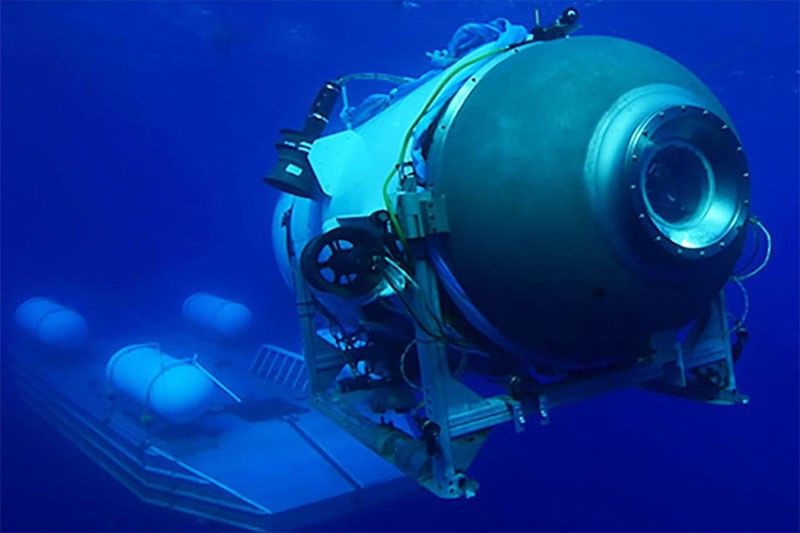Search for missing Titanic sub like 'going into space'

BOSTON, United States — Rescuers trying to find the orca-sized submersible that vanished on its way to visit the wreck of the Titanic are facing a gargantuan task that will test the limits of technical know-how -- with only a very slight chance of success, experts say.
Teams from around the world were racing against the clock Tuesday to locate the vessel and its five-person crew before their oxygen runs out -- with little more than a day's supply left.
But scouring a 7,600-square-mile (20,000-square-kilometer) area of the North Atlantic to a depth of more than two miles (almost four kilometers) is not easy.
"It's pitch black down there. It's freezing cold. The seabed is mud, and it's undulating. You can't see your hand in front of your face," Titanic expert Tim Maltin told NBC News Now.
"It's really a bit like being an astronaut going into space."
The 21-foot (6.5-meter) submersible, named Titan, was carrying three fee-paying passengers when it vanished Sunday: British billionaire Hamish Harding, Pakistani tycoon Shahzada Dawood and Dawood's son Suleman.
OceanGate Expeditions, which runs the Titan's trips, charges $250,000 for a seat.
The company's CEO Stockton Rush and French submarine operator Paul-Henri Nargeolet, nicknamed "Mr Titanic" for his frequent dives at the site, are also aboard.
US Coast Guard Captain Jamie Frederick told reporters Tuesday that his organization was coordinating the search.
But, he said, it was incredibly difficult, and far beyond what the coast guard would normally tackle.
"While the US Coast Guard has assumed the role of search and rescue mission coordinator, we do not have all of the necessary expertise and equipment required in a search of this nature," he said.
"This is a complex search effort, which requires multiple agencies with subject matter expertise and specialized equipment."
Frederick explained that rescuers were using several methods as they comb the vast area for the Titan, which lost contact with its mothership just two hours into its dive near the Titanic's watery grave.
"The search efforts have focused on both surface with C-130 aircraft searching by sight and with radar, and subsurface with P-3 aircraft, we're able to drop and monitor sonar buoys."
Mechanical or electrical failure
So far, the searches have proved fruitless.
The effort was being augmented Tuesday by a huge pipe-laying vessel, which has a remotely operated vehicle expected to be deployed at Titan's last known position.
Jules Jaffe, who was part of the team that found the Titanic in 1985, said there were two likely explanations for the sub's disappearance.
"It's either a mechanical failure, or an electrical failure," he told AFP in La Jolla, California.
"I'm hoping it's an electrical failure, because they do have weights, one of the safety procedures that they have is to make themselves lighter. So if you're heavier than the water, you sink, if you're lighter than the water you float."
Jaffe, a research oceanographer at the University of San Diego, said rescuers would be looking on the surface, in the water column and on the seafloor.
"The worst place for them to be would be on the seafloor, which would imply that the vehicle itself either imploded or got tangled somehow."
Adding to the challenge: the enormous pressure four kilometers under water, around 400 times what it is on the surface.
Such pressures put huge strains on equipment, and very few vessels can survive these depths.
Nuclear submarines generally operate at just 300 meters, according to the Woods Hole Oceanographic Institution.
Jamie Pringle, a professor of forensic geosciences at Keele University in Britain, said if the mini-sub had settled on the ocean floor, it could be very difficult to spot.
"The bottom of the ocean is not flat; there are lots of hills and canyons," Pringle said, according to NBC.
Further complicating the seafloor prognosis is the debris field from the Titanic itself -- the very thing the adventurers had gone to see.
"I mean, it's a mangled wreck, with probably all kinds of treacherous things which would not be very friendly for a small boat," said Jaffe.
"The opportunities for finding them in a mangled wreck within the next 36 hours, I think are practically impossible."
- Latest
- Trending






























